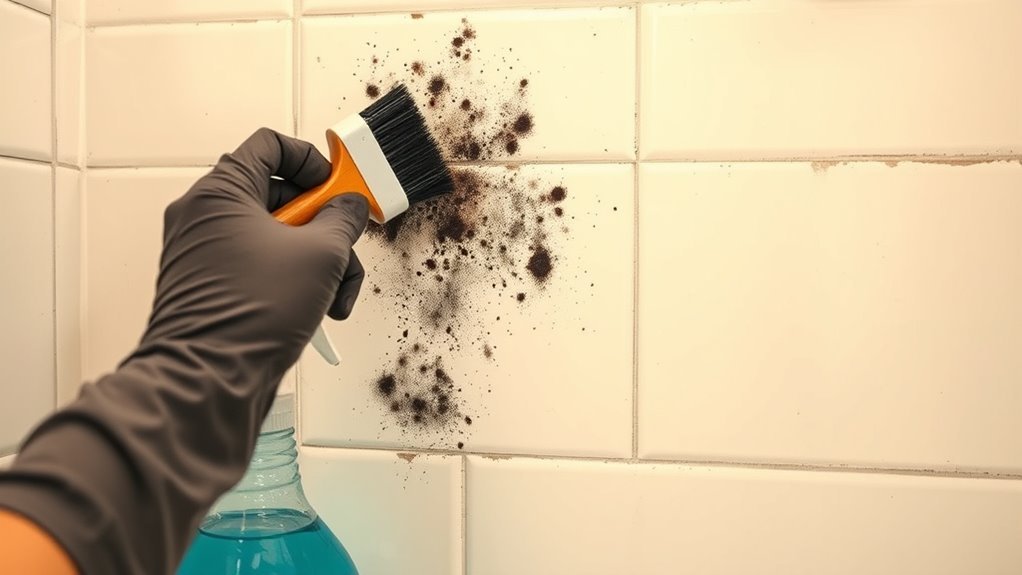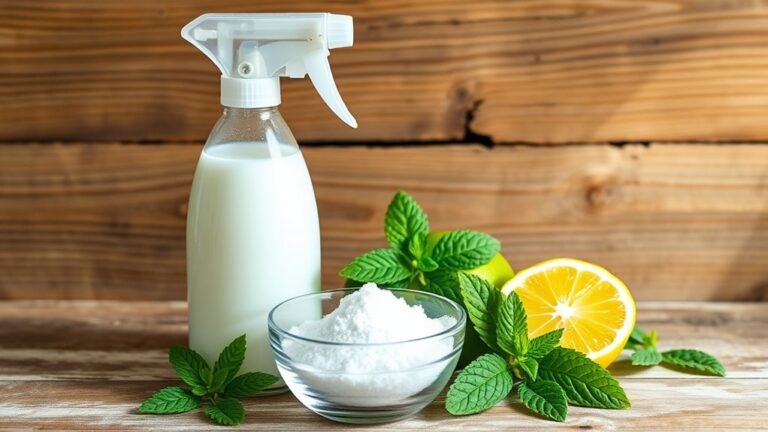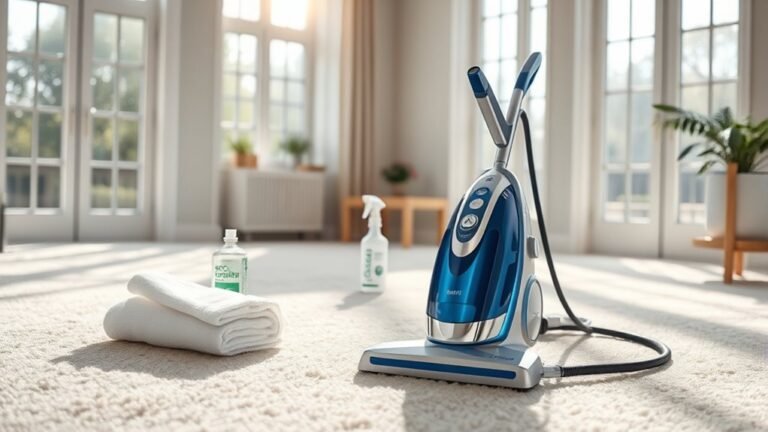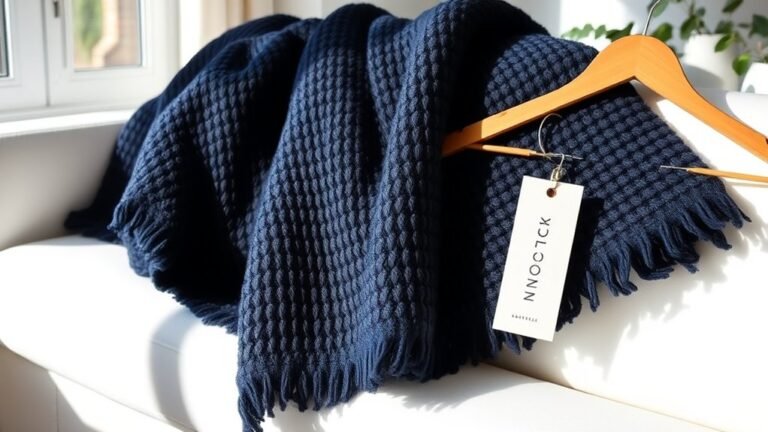Removing Mold Stains From Bathroom
If you want to remove mold stains from your bathroom, start by wearing gloves and a mask to protect yourself. Use natural cleaners like undiluted white vinegar, baking soda paste, or 3% hydrogen peroxide—apply, let sit, then scrub gently. Make sure your bathroom is well-ventilated to help prevent mold from returning. Regular cleaning and good airflow can stop stains before they start. Keep going, and you’ll find tips to make mold removal easier and longer-lasting.
Understanding Mold Growth in Bathrooms
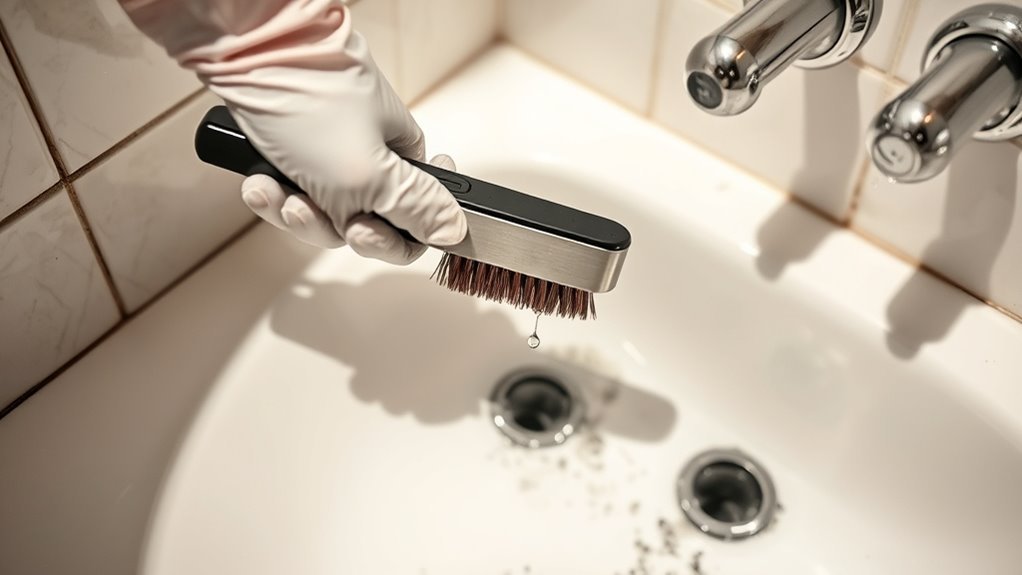
Because bathrooms are often warm and humid, they create the perfect environment for mold to thrive. You need to understand the mold lifecycle to effectively tackle it and reclaim your space. Mold spores settle on damp surfaces where bathroom humidity stays high, allowing them to grow and spread quickly. If you don’t control moisture, mold moves through its lifecycle—spores germinate, grow into colonies, and release more spores, repeating the cycle. You’re not stuck letting mold take over; by managing bathroom humidity and cleaning regularly, you interrupt this lifecycle. Taking control means freedom from mold’s grip and a healthier, fresher bathroom. Remember, understanding how mold grows empowers you to stop it before it becomes a problem.
Common Causes of Mold Stains
Since mold thrives in damp environments, several common factors contribute to the stains you see in your bathroom. One major culprit is moisture accumulation—water from showers, baths, or leaks often lingers on surfaces, creating the perfect breeding ground for mold. You might not notice small puddles or persistent dampness, but they’re enough to encourage mold growth. Another key factor is poor ventilation. Without proper airflow, humidity builds up and stays trapped, making it hard for your bathroom to dry out. This stagnant moisture lets mold settle in corners, grout lines, and ceiling edges. Understanding these causes empowers you to tackle mold stains effectively and regain control of your bathroom space, keeping it fresh, clean, and mold-free.
Safety Precautions Before Cleaning Mold
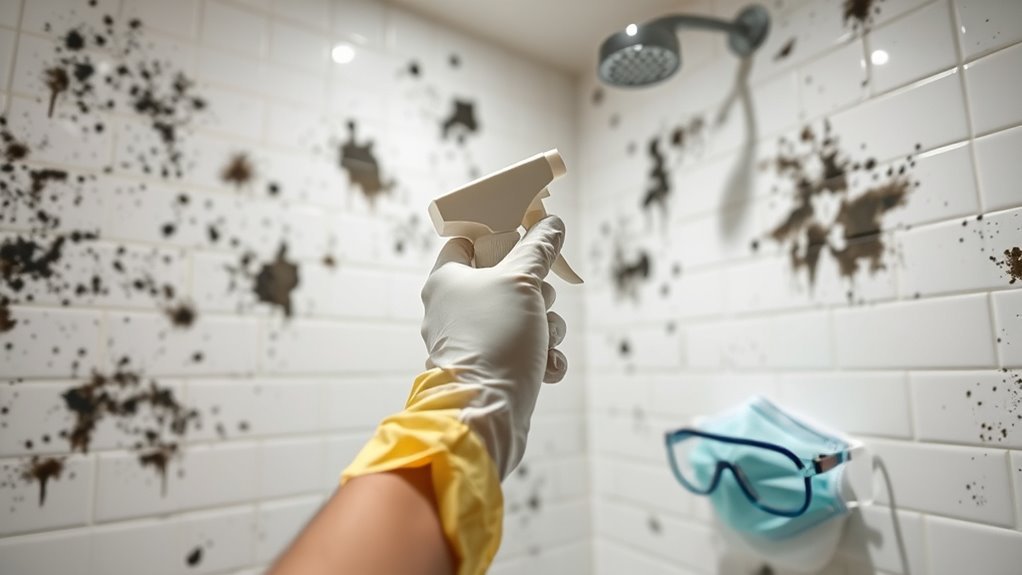
Before you start cleaning mold stains, make certain you wear protective gear like gloves and a mask to keep yourself safe. You’ll also want to guarantee the bathroom is well-ventilated to avoid inhaling mold spores. Taking these precautions helps protect your health while you tackle the stains.
Protective Gear Essentials
Safety is your top priority when tackling mold stains in the bathroom. Before you start scrubbing, gear up with protective gloves to shield your hands from harsh cleaners and mold spores. These gloves are essential—they keep your skin safe and reduce the risk of irritation or infection. Next, don’t skip wearing a respiratory mask. Mold releases spores that can irritate your lungs, especially in tight spaces like bathrooms. A good respiratory mask filters out airborne particles, helping you breathe easy while you work. Make sure your gear fits properly—loose gloves or a poor-fitting mask won’t offer the protection you need. By suiting up right, you’re not just cleaning mold—you’re taking control of your health and your space, confidently and safely.
Ventilation Importance
Although protective gear is essential, proper ventilation is just as important when cleaning mold in your bathroom. You want to breathe freely without worrying about harmful spores lingering in the air. Make sure your ventilation systems are working efficiently—exhaust fans or open windows can help push mold spores outside, reducing your exposure. Good humidity control is key; mold thrives in damp environments, so keeping moisture levels low prevents it from coming back. If your bathroom lacks adequate ventilation, consider installing or upgrading fans to improve airflow. Taking these steps not only protects your health during cleaning but also gives you long-term freedom from recurring mold problems. Remember, fresh air isn’t just a comfort—it’s an essential safety measure.
Using Vinegar to Remove Mold Stains
If you want a natural and effective way to tackle mold stains in your bathroom, vinegar is a great choice. Its vinegar benefits go beyond cooking — it’s a powerful mold removal agent that’s safe and non-toxic. Here’s how you can use it:
- Pour undiluted white vinegar into a spray bottle for maximum strength.
- Spray the vinegar directly onto the moldy area and let it sit for at least an hour to break down mold spores.
- Wipe away the stains with a clean cloth or scrub brush, then let the area air dry to prevent mold from returning.
Using vinegar gives you freedom from harsh chemicals while keeping your bathroom fresh and mold-free.
Applying Baking Soda for Mold Removal
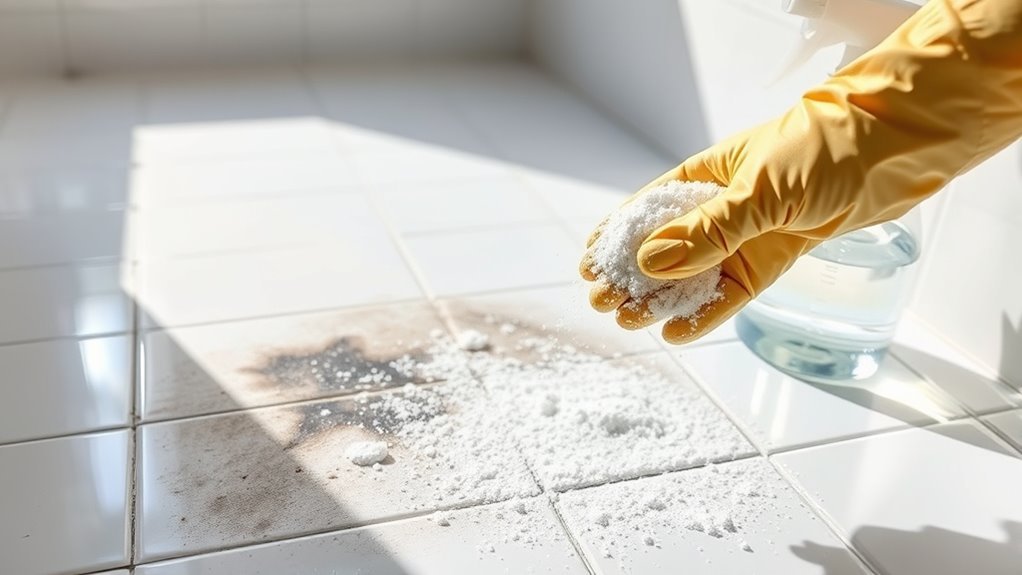
You’ll want to start by mixing baking soda with water to create a paste that’s easy to spread. Applying it directly to mold stains helps lift the grime without harsh chemicals. Let it sit for a while before scrubbing to get the best results.
Baking Soda Preparation
Baking soda is a simple yet effective ingredient for tackling mold stains in your bathroom. Its natural baking soda benefits include deodorizing, scrubbing power, and mild alkalinity, making it ideal for mold removal without harsh chemicals. To prepare baking soda for use:
- Mix half a cup of baking soda with a few tablespoons of water to create a thick paste.
- Stir until smooth, ensuring no lumps remain for easy application.
- Optionally, add a few drops of essential oil for a fresh scent and extra antimicrobial action.
This straightforward preparation sets you up for an efficient, eco-friendly cleaning session, giving you the freedom to maintain a fresh, mold-free bathroom without relying on toxic products.
Effective Application Techniques
Once your baking soda paste is ready, the next step is applying it effectively to tackle those stubborn mold stains. Start by using a clean sponge or soft brush to spread the paste evenly over the affected areas. Focus on thorough coverage, ensuring the paste penetrates the surface for maximum stain removal. Let the paste sit for 10-15 minutes to loosen mold. Then, use gentle scrubbing motions to lift the stains without damaging surfaces. Afterward, rinse with warm water and wipe dry. Remember, consistent application methods like these empower you to control mold without harsh chemicals. Repeating this process weekly helps maintain a fresh, mold-free bathroom, giving you the freedom to enjoy a clean, healthy space.
Utilizing Hydrogen Peroxide for Stubborn Mold
Although stubborn mold stains can be tough to remove, hydrogen peroxide offers a powerful and eco-friendly solution. You’ll appreciate its effectiveness and safety as you regain control over your bathroom’s cleanliness. Here’s how to maximize hydrogen peroxide application for mold stain removal:
- Spray 3% hydrogen peroxide directly onto the moldy surface, ensuring full coverage without dilution.
- Let it sit for 10-15 minutes; this allows the solution to break down mold and lighten stains.
- Scrub gently with a soft brush or cloth, then rinse with water and dry the area thoroughly.
This method not only tackles tough mold but also minimizes harsh chemical exposure, giving you freedom from worry and a fresher bathroom environment.
Preventing Future Mold Growth in Bathroom
To keep mold from coming back in your bathroom, you’ll need to control moisture and improve ventilation. Using mold resistant materials like special paints and drywall helps create a barrier against growth. Don’t forget regular inspections—catching issues early frees you from bigger problems later. Here’s a quick guide:
| Action | Benefit | Frequency |
|---|---|---|
| Use mold resistant materials | Prevents mold buildup | During renovation |
| Improve ventilation | Reduces humidity | Daily |
| Conduct regular inspections | Detects early mold signs | Monthly |
When to Call a Professional Mold Remediation Service
How do you know when it’s time to call a professional mold remediation service? Sometimes, tackling mold yourself isn’t enough, and you need expert help to regain control of your space. Consider scheduling a mold inspection or professional assessment if:
- The mold covers a large area—more than 10 square feet—and keeps coming back despite your efforts.
- You notice mold inside walls, under floors, or in hidden places where moisture lingers.
- You or your family experience unexplained health issues like allergies or respiratory problems that worsen at home.
Calling in pros guarantees thorough removal and prevents mold from stealing your freedom to enjoy a clean, safe bathroom. Don’t hesitate to get expert eyes on the problem and reclaim your space confidently.
Frequently Asked Questions
Can Mold Stains Damage Bathroom Fixtures Permanently?
Mold stains are like shadows creeping over your bathroom’s bright spirit, threatening to dull its shine. If you don’t act, these stains can indeed cause permanent damage to your fixtures, eating away at surfaces and leaving unsightly marks. To keep your space free and fresh, embrace mold prevention techniques like proper ventilation and regular cleaning. Pair that with fixture maintenance tips—like sealing cracks and drying surfaces—to guarantee your bathroom stays as free as you want it to be.
Are There Eco-Friendly Commercial Mold Removers Available?
Yes, you’ll find plenty of eco-friendly commercial mold removers that use natural ingredients, letting you clean without harming the planet. Many biodegradable options break down quickly, so you’re free from harsh chemicals and guilt. These products work well while keeping your space safe and fresh. Choosing them means you’re taking care of your home and the environment, giving you the freedom to clean confidently and sustainably.
How Often Should Bathroom Ventilation Fans Be Cleaned?
Think of your bathroom ventilation fan as the lungs of your space, breathing out moisture and keeping the air fresh. For ideal bathroom maintenance and to uphold ventilation importance, you should clean those fans every three to six months. This routine guarantees they don’t get clogged or less effective, giving you the freedom to enjoy a mold-free, crisp environment without worry. Regular care keeps your bathroom’s breath steady and strong.
Is Mold Removal Safe During Pregnancy or for Pets?
When it comes to mold removal safety during pregnancy, you should be extra cautious. Mold exposure can affect your health, so it’s best to avoid harsh chemicals and guarantee good ventilation. Opt for natural cleaning alternatives or get someone else to handle it. For pets, keep them away from treated areas until everything’s dry and safe. Taking these pregnancy precautions helps you protect both yourself and your furry friends while keeping your space mold-free.
Can Mold Stains Cause Allergic Reactions in Sensitive Individuals?
Yes, mold stains can definitely cause allergic reactions if you’re sensitive. When you encounter mold allergies, your body might react with sneezing, itching, or even respiratory issues. If you’re someone who’s prone to sensitive reactions, it’s smart to manage your exposure and keep your environment clean. Don’t let mold limit your freedom—taking steps to reduce it helps you breathe easier and live comfortably without constant irritation.
